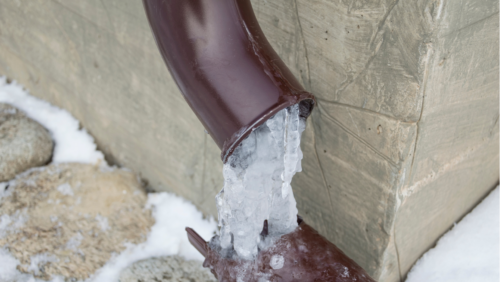Winterize Your DC Home

A surprising amount of damage can result from failure to take frigid weather precautions in Washington DC. Create annual and seasonal checklists for the care and maintenance of your home in all weather conditions.
Follow these steps to combat weather wear and tear year-round, and be sure to effectively winterize your Washington DC home.
Bullet Points
- Assemble tools and materials
- Order safety items first
- Create an annual checklist
- Create a seasonal checklist
Safety Equipment
If you take only one step in winterizing your Washington DC home, make it this one: Evaluate and update your safety systems, devices and components. There’s nothing more important that keeping yourself and your family safe and secure in harsh weather conditions.
- Test smoke and carbon monoxide detectors. Change batteries whether or not its needed, and update the devices with newer models if they’re more than four years old
- If none exist, install carbon monoxide detectors in rooms with furnaces and/or water heaters
- Check security alarm systems, including door and window contacts, service box and wiring. Schedule your security company annual review
- Check and test battery back-ip systems for sump pumps and the pump itself. Repair or replace as needed
- Install moisture detectors near water heaters and washing machines
- Replace fire extinguishers if they are more than five years old
- Locate your flashlights, replace batteries whether or not its needed, and store where they’re easily accessible in an emergency situation
Emergency Kit
HVAC Systems
Heating, ventilation, and air conditioning are among the most expensive components of your home, cruicial to hot and cold winter month comfort, and the most important to maintain regularly to prevent expensive replacement and repairs.
- Your HVAC system should be serviced each fall and summer. It is important to include an AC check in your fall service visit since you will not be able to operate the AC system during frigid winter and spring months. A check of your heating system each fall will ensure a safe and effective heating system for your family in the winter and early spring
- Have a certified pro perform a furnace inspection and duct cleaning before you switch the heat on for the season
- Clean your wall, floor and ceiling vent covers to prevent dust and debris from traveling through your home
- Keep 3 months’ supply of furnace filters and change them as instructed by the product manufacturer
- Replace your old thermostat with an programmable model to save on energy costs. Choose a model that allows you to operate the system from your phone if you are away from home for extended periods of time
- Bleed radiator valves.
Plumbing
Plumbing and winter have a contentious relationship. Uninsulated pipes can take down your house in a matter of hours during a major freeze. Take precautions in late summer so nasty winter weather events don’t threaten your structure.
- Seal exposed areas around interior and exterior pipes
- Locate your main water shutoff value in case of emergency and leave a note on the refrigerator clearly stating its location
- Drain all garden hoses and remove from exterior spigots. Shut off water to the spigots from the main shutoff and open all exterior valves to drain. Leave open until the 3rd consecutive week in spring with temperatures above 68 degrees
- Insulate every exposed plumbing pipe, and those beneath homes and other structures
- Drain air conditioner pipes and turn off shut-off valve, seal areas around the unit if leaving installed. Seal faceplate for the season to prevent infiltration of air, insects and other pests
- Always leave heat on in the winter, even if you’re away, to protect your plumbing. Keep at a minimum of 62 degrees.
Fireplace And Chimney
Doors And Windows
When you winterize your DC home, be sure to address air infiltration from doors and windows, along with their condition and operation.
- Check door locks and hardware. If your locks are “sticky” or keys have been lost, replace them in late summer. Lock issues worsen when wood swells or contracts during season changes, and locks get icy in winter. Update any hardware that isn’t functioning properly, has deteriorated, or is visibly stressed due to load or misuse
- Evaluate your doors. If doors are rotting, gaping, sifting or sticking, have them evaluated and repaired, or consider replacing them. Rescreen screen doors as needed, remove, clean and store mid-fall, and replace with storm doors
- Check windows to make sure they’re in good working order, repair as needed. If your DC home has window grilles installed, check for rust, rot and peeling or chipping paint, loose or missing screws, and inoperable locks. Fix or replace elements as necessary to ensure effective entry prevention and smooth emergency exit acccess. If your windows need replacement, late summer is an ideal time. Keep in mind that the replacement process includes permitting and HPO review in DC’s historic districts
- Apply weather stripping to doors where necessary to block cold drafts
- Caulk windows to seal out frigid air
- Cover basement windows and install storm windows
- Sand/scrape, prime and paint exposed wood on the exterior of the home to prevent weather damage
Roof
- In early fall, inspect roof, gutters & downspouts for gaps, peeling, deterioration of rubber roofs, missing or loose shingles, flashing or tiles
- Add additional insulation to your attic if needed, and be sure to apply it evenly
- Clean gutters and flush downspouts with a strong stream of water
- Install leaf guards to keep your gutters free of clogs
- Install downspout extensions to direct water away from the home.
Foundation
When you winterize your DC home, don’t forget about a less visible, but key component: its foundation. Your home’s foundation is its most important element and one of the most expensive to repair if significant damage is done. Prevent deterioration with good annual maintenance and be sure to check the landscaping checklist on this page for key measures that relate to your home’s foundation.
- Rake material and vegetation away from the foundation in late summer and early fall. Take this opportunity to inspect for cracks, gaps and deterioration or damage
- If noticeable wear or damage is found, contact a structural engineer for an inspection, then hire a certified professional to make recommended foundation repairs. This will help prevent damage to the rest of your home
- Seal exterior window sills and surrounding areas to prevent leakage, exposure damage, dry rot and pest activity
- Seal, repair and secure all crawlspace entrances
Landscaping
Home owners are often surprised to learn that their landscaping is to blame for roof, foundation and flooding issues. Here’s what you can do to minimize risk:
- Trim tree branches close to the home and electrical wires. Check with a pro regarding timing so as not to damage the trees
- Repair and seal driveways, patios and decks
- Have a landscape grading expert evaluate the grading of your front and rear yards. This is typically handled by a civil engineer. An evaluation should cost a few hundred dollars and could save you many thousands. An effective grading plan diverts water away from your home to an approved storm drain system. If your yards aren’t correctly graded, water from storms and irrigation can run back toward the home and cause damage to the foundation wall, or saturate the soil next to the foundation causing hydrostatic pressure against the wall, resulting in foundation cracks, structural damage and soil erosion. An improperly graded lot can also cause issues for your neighbors, for which you could be held liable. Late summer is a perfect time of year to make adjustments.
Tools And Equipment
- Clean, dry and store summer gardening equipment to prevent damage, and sharpen tools as needed to ready them for early spring work
- Replace any equipment that can not be repaired
- Service your snowblower if you have one
- Drain gas-powered lawnmower, clean and store in dry place with accessories nearby
- Buy ice-melt, rock salt and/or sand supplies for steps, driveway and walkways. If you wait until late fall, you may find a limited supply
- Prepare for power outages by purchasing a portable generator to power a emergency lights and your refrigerator. Follow instructions carefully and be sure to ventilate well

